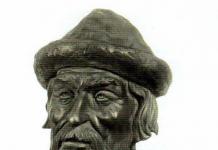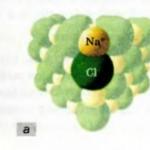Collection of basic formulas for a school chemistry course
Collection of basic formulas for a school chemistry course
G. P. Loginova
Elena Savinkina
E. V. Savinkina G. P. Loginova
Collection of basic formulas in chemistry
Student's Pocket Guide
general chemistry
The most important chemical concepts and laws
Chemical element- this is a certain type of atom with the same nuclear charge.
Relative atomic mass(A r) shows how many times the mass of an atom of a given chemical element is greater than the mass of a carbon-12 atom (12 C).
Chemical substance– a collection of any chemical particles.
Chemical particles
Formula unit– a conventional particle, the composition of which corresponds to the given chemical formula, for example:Ar – argon substance (consists of Ar atoms),
H 2 O – the substance water (consists of H 2 O molecules),
KNO 3 – potassium nitrate substance (consists of K + cations and NO 3 ¯ anions).
Relationships between physical quantities
Atomic mass (relative) of the element B, A r (B):Where *T(atom B) – mass of an atom of element B;
*t and– atomic mass unit;
*t and = 1/12 T(12 C atom) = 1.6610 24 g.
Quantity of substance B, n(B), mol:
Where N(B)– number of particles B;
N A– Avogadro’s constant (N A = 6.0210 23 mol -1).
Molar mass of a substance V, M(V), g/mol:
Where t(V)– mass B.
Molar volume of gas IN, V M l/mol:
Where V M = 22.4 l/mol (a consequence of Avogadro’s law), under normal conditions (no. – atmospheric pressure p = 101,325 Pa (1 atm); thermodynamic temperature T = 273.15 K or Celsius temperature t = 0 °C).
B for hydrogen, D(gas B by H 2):
*Density of gaseous substance IN by air, D(gas B over air): Mass fraction of element E in matter V, w(E):Where x is the number of E atoms in the formula of substance B
The structure of the atom and the Periodic Law D.I. Mendeleev
Mass number (A) – the total number of protons and neutrons in the atomic nucleus:
A = N(p 0) + N(p +).
Atomic nuclear charge (Z) equal to the number of protons in the nucleus and the number of electrons in the atom:Z = N(p+) = N(e¯).
Isotopes– atoms of the same element, differing in the number of neutrons in the nucleus, for example: potassium-39: 39 K (19 p + , 20n 0, 19e¯); potassium-40: 40 K (19 p+, 21n 0, 19e¯).*Energy levels and sublevels
*Atomic orbital(AO) characterizes the region of space in which the probability of an electron having a certain energy being located is greatest.*Shapes of s- and p-orbitals
Periodic law and periodic system D.I. Mendeleev
The properties of elements and their compounds are periodically repeated with increasing atomic number, which is equal to the charge of the nucleus of the element’s atom.Period number corresponds number of energy levels filled with electrons, and stands for the last energy level to be filled(EU).
Group number A shows And etc.
Group number B shows number of valence electrons ns And (n – 1)d.
S-elements section– the energy sublevel (ESL) is filled with electrons ns-EPU– IA- and IIA-groups, H and He.
p-elements section– filled with electrons np-EPU– IIIA-VIIIA-groups.
D-elements section– filled with electrons (P- 1) d-EPU – IB-VIIIB2-groups.
f-elements section– filled with electrons (P-2) f-EPU – lanthanides and actinides.
Changes in the composition and properties of hydrogen compounds of elements of the 3rd period of the Periodic Table
Non-volatile, decomposes with water: NaH, MgH 2, AlH 3.Volatile: SiH 4, PH 3, H 2 S, HCl.
Changes in the composition and properties of higher oxides and hydroxides of elements of the 3rd period of the Periodic Table
Basic: Na 2 O – NaOH, MgO – Mg(OH) 2.Amphoteric: Al 2 O 3 – Al(OH) 3.
Acidic: SiO 2 – H 4 SiO 4, P 2 O 5 – H 3 PO 4, SO 3 – H 2 SO 4, Cl 2 O 7 – HClO 4.
Chemical bond
Electronegativity(χ) is a quantity characterizing the ability of an atom in a molecule to acquire a negative charge.Mechanisms of covalent bond formation
Exchange mechanism- the overlap of two orbitals of neighboring atoms, each of which had one electron.Donor-acceptor mechanism– overlap of a free orbital of one atom with an orbital of another atom that contains a pair of electrons.
Overlap of orbitals during bond formation
*Type of hybridization – geometric shape of the particle – angle between bonds
Hybridization of central atom orbitals– alignment of their energy and form.sp– linear – 180°
sp 2– triangular – 120°
sp 3– tetrahedral – 109.5°
sp 3 d– trigonal-bipyramidal – 90°; 120°
sp 3 d 2– octahedral – 90°
Mixtures and solutions
Solution- a homogeneous system consisting of two or more substances, the content of which can be varied within certain limits.
Solution: solvent (eg water) + solute.
True solutions contain particles smaller than 1 nanometer.
Colloidal solutions contain particles ranging in size from 1 to 100 nanometers.
Mechanical mixtures(suspensions) contain particles larger than 100 nanometers.
Suspension=> solid + liquid
Emulsion=> liquid + liquid
Foam, fog=> gas + liquid
Heterogeneous mixtures are separated settling and filtering.
Homogeneous mixtures are separated evaporation, distillation, chromatography.
Saturated solution is or may be in equilibrium with the solute (if the solute is solid, then its excess is in the precipitate).
Solubility– the content of the dissolved substance in a saturated solution at a given temperature.
Unsaturated solution less,
Supersaturated solution contains solute more, than its solubility at a given temperature.
Relationships between physicochemical quantities in solution
Mass fraction of solute IN, w(B); fraction of a unit or %:Where t(V)– mass B,
t(r)– mass of solution.
Weight of solution, m(p), g:
m(p) = m(B) + m(H 2 O) = V(p) ρ(p),
where F(p) is the volume of the solution;ρ(p) – solution density.
Volume of solution, V(p), l:
Molar concentration, s(V), mol/l:Where n(B) is the amount of substance B;
M(B) – molar mass of substance B.
Changing the composition of the solution
Diluting the solution with water:> t"(V)= t(B);
> the mass of the solution increases by the mass of added water: m"(p) = m(p) + m(H 2 O).
Evaporating water from a solution:
> the mass of the solute does not change: t"(B) = t(B).
> the mass of the solution decreases by the mass of evaporated water: m"(p) = m(p) – m(H 2 O).
Merging two solutions: The masses of solutions, as well as the masses of the dissolved substance, add up:
t"(B) = t(B) + t"(B);
t"(p) = t(p) + t"(p).
Crystal Drop: the mass of the solute and the mass of the solution are reduced by the mass of precipitated crystals:
m"(B) = m(B) – m(sediment); m"(p) = m(p) – m(sediment).
The mass of water does not change.
Thermal effect of a chemical reaction
*Enthalpy of formation of a substance ΔH°(B), kJ/mol, is the enthalpy of the reaction of formation of 1 mole of a substance from simple substances in their standard states, that is, at constant pressure (1 atm for each gas in the system or at a total pressure of 1 atm in the absence of gaseous reaction participants) and constant temperature (usually 298 K , or 25 °C).*Thermal effect of a chemical reaction (Hess’s law)
Q = ΣQ(products) – ΣQ(reagents).
ΔН° = ΣΔН°(products) – Σ ΔН°(reagents).
For reaction aA + bB +… = dD + eE +…ΔH° = (dΔH°(D) + eΔH°(E) +…) – (aΔH°(A) + bΔH°(B) +…),
Where a, b, d, e– stoichiometric amounts of substances corresponding to the coefficients in the reaction equation.Chemical reaction rate
If during time τ in volume V the amount of reactant or product changed by Δ n, speed reaction:
For a monomolecular reaction A →…:
v = k c(A).
For the bimolecular reaction A + B → ...:v = k c(A) c(B).
For the trimolecular reaction A + B + C → ...:v = k c(A) c(B) c(C).
Changing the rate of a chemical reaction
Speed reaction increase:1) chemically active reagents;
2) promotion reagent concentrations;
3) increase
4) promotion temperature;
5) catalysts. Speed reaction reduce:
1) chemically inactive reagents;
2) demotion reagent concentrations;
3) decrease surfaces of solid and liquid reagents;
4) demotion temperature;
5) inhibitors.
*Temperature speed coefficient(γ) is equal to a number that shows how many times the reaction rate increases when the temperature increases by ten degrees:
Chemical equilibrium
*Law of mass action for chemical equilibrium: in a state of equilibrium, the ratio of the product of the molar concentrations of products in powers equal to
Their stoichiometric coefficients, to the product of the molar concentrations of the reactants in powers equal to their stoichiometric coefficients, at a constant temperature is a constant value (concentration equilibrium constant).
In a state of chemical equilibrium for a reversible reaction:
aA + bB + … ↔ dD + fF + …
K c = [D] d [F] f .../ [A] a [B] b ...
*Shift in chemical equilibrium towards the formation of products
1) Increasing the concentration of reagents;2) reducing the concentration of products;
3) increase in temperature (for an endothermic reaction);
4) decrease in temperature (for an exothermic reaction);
5) increase in pressure (for a reaction occurring with a decrease in volume);
6) decrease in pressure (for a reaction occurring with an increase in volume).
Exchange reactions in solution
Electrolytic dissociation– the process of formation of ions (cations and anions) when certain substances are dissolved in water.
acids are formed hydrogen cations And acid anions, For example:
HNO 3 = H + + NO 3 ¯
During electrolytic dissociation reasons are formed metal cations and hydroxide ions, for example:NaOH = Na + + OH¯
During electrolytic dissociation salts(medium, double, mixed) are formed metal cations and acid anions, for example:NaNO 3 = Na + + NO 3 ¯
KAl(SO 4) 2 = K + + Al 3+ + 2SO 4 2-
During electrolytic dissociation acid salts are formed metal cations and acid hydroanions, for example:NaHCO 3 = Na + + HCO 3 ‾
Some strong acids
HBr, HCl, HClO 4, H 2 Cr 2 O 7, HI, HMnO 4, H 2 SO 4, H 2 SeO 4, HNO 3, H 2 CrO 4Some strong reasons
RbOH, CsOH, KOH, NaOH, LiOH, Ba(OH) 2, Sr(OH) 2, Ca(OH) 2Dissociation degree α– the ratio of the number of dissociated particles to the number of initial particles.
At constant volume:
Classification of substances by degree of dissociation
Berthollet's rule
Exchange reactions in solution proceed irreversibly if the result is the formation of a precipitate, gas, or weak electrolyte.Examples of molecular and ionic reaction equations
1. Molecular equation: CuCl 2 + 2NaOH = Cu(OH) 2 ↓ + 2NaCl“Complete” ionic equation: Сu 2+ + 2Сl¯ + 2Na + + 2OH¯ = Cu(OH) 2 ↓ + 2Na + + 2Сl¯
“Short” ionic equation: Cu 2+ + 2OH¯ = Cu(OH) 2 ↓
2. Molecular equation: FeS (T) + 2HCl = FeCl 2 + H 2 S
“Complete” ionic equation: FeS + 2H + + 2Сl¯ = Fe 2+ + 2Сl¯ + H 2 S
“Short” ionic equation: FeS (T) + 2H + = Fe 2+ + H 2 S
3. Molecular equation: 3HNO 3 + K 3 PO 4 = H 3 PO 4 + 3KNO 3
“Complete” ionic equation: 3H + + 3NO 3 ¯ + 3K + + PO 4 3- = H 3 PO 4 + 3K + + 3NO 3 ¯
“Short” ionic equation: 3H + + PO 4 3- = H 3 PO 4
*Hydrogen value
(pH) pH = – log = 14 + log*pH range for dilute aqueous solutions
pH 7 (neutral environment)Examples of exchange reactions
Neutralization reaction- an exchange reaction that occurs when an acid and a base interact.1. Alkali + strong acid: Ba(OH) 2 + 2HCl = BaCl 2 + 2H 2 O
Ba 2+ + 2ON¯ + 2H + + 2Сl¯ = Ba 2+ + 2Сl¯ + 2Н 2 O
H + + OH¯ = H 2 O
2. Slightly soluble base + strong acid: Cu(OH) 2(t) + 2HCl = CuCl 2 + 2H 2 O
Cu(OH) 2 + 2H + + 2Cl¯ = Cu 2+ + 2Cl¯ + 2H 2 O
Cu(OH) 2 + 2H + = Cu 2+ + 2H 2 O
*Hydrolysis– an exchange reaction between a substance and water without changing the oxidation states of atoms.
1. Irreversible hydrolysis of binary compounds:
Mg 3 N 2 + 6H 2 O = 3Mg(OH) 2 + 2NH 3
2. Reversible hydrolysis of salts:
A) Salt is formed a strong base cation and a strong acid anion:
NaCl = Na + + Сl¯
Na + + H 2 O ≠ ;
Cl¯ + H 2 O ≠
There is no hydrolysis; neutral environment, pH = 7.
B) Salt is formed a strong base cation and a weak acid anion:
Na 2 S = 2Na + + S 2-
Na + + H 2 O ≠
S 2- + H 2 O ↔ HS¯ + OH¯
Hydrolysis by anion; alkaline environment, pH >7.
B) Salt is formed a cation of a weak or slightly soluble base and an anion of a strong acid:
End of introductory fragment.
Text provided by LitRes LLC.
You can safely pay for the book with a Visa, MasterCard, Maestro bank card, from a mobile phone account, from a payment terminal, in an MTS or Svyaznoy store, via PayPal, WebMoney, Yandex.Money, QIWI Wallet, bonus cards or another method convenient for you.
Check information. It is necessary to check the accuracy of the facts and reliability of the information presented in this article. On the talk page there is a discussion on the topic: Doubts regarding terminology. Chemical formula ... Wikipedia
A chemical formula reflects information about the composition and structure of substances using chemical symbols, numbers and dividing symbols of brackets. Currently, the following types of chemical formulas are distinguished: The simplest formula. Can be obtained by experienced... ... Wikipedia
A chemical formula reflects information about the composition and structure of substances using chemical symbols, numbers and dividing symbols of brackets. Currently, the following types of chemical formulas are distinguished: The simplest formula. Can be obtained by experienced... ... Wikipedia
A chemical formula reflects information about the composition and structure of substances using chemical symbols, numbers and dividing symbols of brackets. Currently, the following types of chemical formulas are distinguished: The simplest formula. Can be obtained by experienced... ... Wikipedia
A chemical formula reflects information about the composition and structure of substances using chemical symbols, numbers and dividing symbols of brackets. Currently, the following types of chemical formulas are distinguished: The simplest formula. Can be obtained by experienced... ... Wikipedia
Main article: Inorganic compounds List of inorganic compounds by element informational list of inorganic compounds presented in alphabetical order (by formula) for each substance, hydrogen acids of the elements (if ... ... Wikipedia
This article or section needs revision. Please improve the article in accordance with the rules for writing articles... Wikipedia
A chemical equation (equation of a chemical reaction) is a conventional representation of a chemical reaction using chemical formulas, numerical coefficients and mathematical symbols. The equation of a chemical reaction gives qualitative and quantitative... ... Wikipedia
Chemical software are computer programs used in the field of chemistry. Contents 1 Chemical editors 2 Platforms 3 Literature ... Wikipedia
Books
- Japanese-English-Russian dictionary for installation of industrial equipment. About 8,000 terms, Popova I.S. The dictionary is intended for a wide range of users and primarily for translators and technical specialists involved in the supply and implementation of industrial equipment from Japan or...
- A brief dictionary of biochemical terms, Kunizhev S.M.. The dictionary is intended for students of chemical and biological specialties at universities studying a course in general biochemistry, ecology and fundamentals of biotechnology, and can also be used in ...
several basic concepts and formulas.
All substances have different mass, density and volume. A piece of metal from one element can weigh many times more than an exactly the same size piece of another metal.
Mole(number of moles)
designation: mole, international: mol- a unit of measurement for the amount of a substance. Corresponds to the amount of substance that contains N.A. particles (molecules, atoms, ions) Therefore, a universal quantity was introduced - number of moles. A frequently encountered phrase in tasks is “received... mole of substance"
N.A.= 6.02 1023
N.A.- Avogadro's number. Also “a number by agreement.” How many atoms are there in the tip of a pencil? About a thousand. It is not convenient to operate with such quantities. Therefore, chemists and physicists around the world agreed - let’s designate 6.02 × 1023 particles (atoms, molecules, ions) as 1 mole substances.
1 mole = 6.02 1023 particles
This was the first of the basic formulas for solving problems.
Molar mass of a substance
Molar mass substance is the mass of one mole of substance.
Denoted as Mr. It is found according to the periodic table - it is simply the sum of the atomic masses of a substance.
For example, we are given sulfuric acid - H2SO4. Let's calculate the molar mass of a substance: atomic mass H = 1, S-32, O-16.
Mr(H2SO4)=1 2+32+16 4=98 g\mol.
The second necessary formula for solving problems is
substance mass formula:
That is, to find the mass of a substance, you need to know the number of moles (n), and we find the molar mass from the Periodic Table.
Law of conservation of mass - The mass of substances that enter into a chemical reaction is always equal to the mass of the resulting substances.
If we know the mass(es) of the substances that reacted, we can find the mass(es) of the products of that reaction. And vice versa.
The third formula for solving chemistry problems is
volume of substance:
Sorry, this image does not meet our guidelines. To continue publishing, please delete the image or upload another one.Where did the number 22.4 come from? From Avogadro's law:
equal volumes of different gases taken at the same temperature and pressure contain the same number of molecules.
According to Avogadro's law, 1 mole of an ideal gas under normal conditions (n.s.) has the same volume Vm= 22.413 996(39) l
That is, if in the problem we are given normal conditions, then, knowing the number of moles (n), we can find the volume of the substance.
So, basic formulas for solving problems in chemistry
Avogadro's numberN.A.
6.02 1023 particles
Quantity of substance n (mol)
n=V\22.4 (l\mol)
Mass of substance m (g)
Volume of substance V(l)
V=n 22.4 (l\mol)
Sorry, this image does not meet our guidelines. To continue publishing, please delete the image or upload another one.These are formulas. Often, to solve problems, you first need to write the reaction equation and (required!) arrange the coefficients - their ratio determines the ratio of moles in the process.
>> Chemical formulas
Chemical formulas
The material in this paragraph will help you:
> find out what the chemical formula is;
> read the formulas of substances, atoms, molecules, ions;
> use the term “formula unit” correctly;
> compose chemical formulas of ionic compounds;
> characterize the composition of a substance, molecule, ion using a chemical formula.
Chemical formula.
Everyone has it substances there is a name. However, by its name it is impossible to determine what particles a substance consists of, how many and what kind of atoms are contained in its molecules, ions, and what charges the ions have. The answers to such questions are given by a special record - a chemical formula.
A chemical formula is the designation of an atom, molecule, ion or substance using symbols chemical elements and indexes.
The chemical formula of an atom is the symbol of the corresponding element. For example, the Aluminum atom is designated by the symbol Al, the Silicon atom by the symbol Si. Simple substances also have such formulas - the metal aluminum, the non-metal of atomic structure silicon.
Chemical formula molecules of a simple substance contains the symbol of the corresponding element and the subscript - a small number written below and to the right. The index indicates the number of atoms in the molecule.
An oxygen molecule consists of two oxygen atoms. Its chemical formula is O 2. This formula is read by first pronouncing the symbol of the element, then the index: “o-two”. The formula O2 denotes not only the molecule, but also the substance oxygen itself.
The O2 molecule is called diatomic. The simple substances Hydrogen, Nitrogen, Fluor, Chlorine, Bromine, and Iodine consist of similar molecules (their general formula is E 2).
Ozone contains three-atomic molecules, white phosphorus contains four-atomic molecules, and sulfur contains eight-atomic molecules. (Write the chemical formulas of these molecules.)
H 2
O2
N 2
Cl2
BR 2
I 2
In the formula of a molecule of a complex substance, the symbols of the elements whose atoms are contained in it, as well as indices, are written down. A carbon dioxide molecule consists of three atoms: one carbon atom and two oxygen atoms. Its chemical formula is CO 2 (read “tse-o-two”). Remember: if a molecule contains one atom of any element, then the corresponding index, i.e. I, is not written in the chemical formula. The formula of a carbon dioxide molecule is also the formula of the substance itself.
In the formula of an ion, its charge is additionally written down. To do this, use a superscript. It indicates the amount of charge with a number (they do not write one), and then a sign (plus or minus). For example, a Sodium ion with a charge +1 has the formula Na + (read “sodium-plus”), a Chlorine ion with a charge - I - SG - (“chlorine-minus”), a hydroxide ion with a charge - I - OH - (“ o-ash-minus"), a carbonate ion with a charge -2 - CO 2- 3 (“ce-o-three-two-minus”).
Na+,Cl-
simple ions
OH - , CO 2- 3
complex ions
In the formulas of ionic compounds, first write down, without indicating charges, positively charged ions, and then - negatively charged (Table 2). If the formula is correct, then the sum of the charges of all ions in it is zero.
table 2
Formulas of some ionic compounds
In some chemical formulas, a group of atoms or a complex ion is written in parentheses. As an example, let's take the formula of slaked lime Ca(OH) 2. This is an ionic compound. In it, for every Ca 2+ ion there are two OH - ions. The formula of the compound reads " calcium-o-ash-twice”, but not “calcium-o-ash-two”.
Sometimes in chemical formulas, instead of symbols of elements, “foreign” letters, as well as index letters, are written. Such formulas are often called general. Examples of formulas of this type: ECI n, E n O m, F x O y. First
the formula denotes a group of compounds of elements with Chlorine, the second - a group of compounds of elements with Oxygen, and the third is used if the chemical formula of a compound of Ferrum with Oxygen unknown and
it should be installed.
If you need to designate two separate Neon atoms, two oxygen molecules, two carbon dioxide molecules or two Sodium ions, use the notations 2Ne, 20 2, 2C0 2, 2Na +. The number in front of the chemical formula is called the coefficient. Coefficient I, like index I, is not written.
Formula unit.
What does the notation 2NaCl mean? NaCl molecules do not exist; table salt is an ionic compound that consists of Na + and Cl - ions. A pair of these ions is called the formula unit of a substance (it is highlighted in Fig. 44, a). Thus, the notation 2NaCl represents two formula units of table salt, i.e., two pairs of Na + and C l- ions.
The term “formula unit” is used for complex substances not only of ionic but also of atomic structure. For example, the formula unit for quartz SiO 2 is the combination of one Silicium atom and two Oxygen atoms (Fig. 44, b).

Rice. 44. formula units in compounds of ionic (a) atomic structure (b)
A formula unit is the smallest “building block” of a substance, its smallest repeating fragment. This fragment can be an atom (in a simple substance), molecule(in a simple or complex substance),
a collection of atoms or ions (in a complex substance).
Exercise. Draw up a chemical formula for a compound that contains Li + i SO 2- 4 ions. Name the formula unit of this substance.
Solution
In an ionic compound, the sum of the charges of all ions is zero. This is possible provided that for each SO 2- 4 ion there are two Li + ions. Hence the formula of the compound is Li 2 SO 4.
The formula unit of a substance is three ions: two Li + ions and one SO 2- 4 ion.
Qualitative and quantitative composition of a substance.
A chemical formula contains information about the composition of a particle or substance. When characterizing the qualitative composition, they name the elements that form a particle or substance, and when characterizing the quantitative composition, they indicate:
The number of atoms of each element in a molecule or complex ion;
the ratio of atoms of different elements or ions in a substance.
Exercise. Describe the composition of methane CH 4 (molecular compound) and soda ash Na 2 CO 3 (ionic compound)
Solution
Methane is formed by the elements Carbon and Hydrogen (this is a qualitative composition). A methane molecule contains one carbon atom and four hydrogen atoms; their ratio in the molecule and in the substance
N(C): N(H) = 1:4 (quantitative composition).
(The letter N denotes the number of particles - atoms, molecules, ions.
Soda ash is formed by three elements - Sodium, Carbon and Oxygen. It contains positively charged Na + ions, since Sodium is a metallic element, and negatively charged CO -2 3 ions (qualitative composition).
The ratio of atoms of elements and ions in a substance is as follows:
conclusions
A chemical formula is a recording of an atom, molecule, ion, substance using symbols of chemical elements and indices. The number of atoms of each element is indicated in the formula using a subscript, and the charge of the ion is indicated by a superscript.
Formula unit is a particle or collection of particles of a substance represented by its chemical formula.
The chemical formula reflects the qualitative and quantitative composition of a particle or substance.
?
66. What information about a substance or particle does a chemical formula contain?
67. What is the difference between a coefficient and a subscript in chemical notation? Complete your answer with examples. What is the superscript used for?
68. Read the formulas: P 4, KHCO 3, AI 2 (SO 4) 3, Fe(OH) 2 NO 3, Ag +, NH + 4, CIO - 4.
69. What do the entries mean: 3H 2 0, 2H, 2H 2, N 2, Li, 4Cu, Zn 2+, 50 2-, NO - 3, 3Ca(0H) 2, 2CaC0 3?
70. Write down chemical formulas that read like this: es-o-three; boron-two-o-three; ash-en-o-two; chrome-o-ash-thrice; sodium-ash-es-o-four; en-ash-four-double-es; barium-two-plus; pe-o-four-three-minus.
71. Make up the chemical formula of a molecule that contains: a) one Nitrogen atom and three Hydrogen atoms; b) four atoms of Hydrogen, two atoms of Phosphorus and seven atoms of Oxygen.
72. What is the formula unit: a) for soda ash Na 2 CO 3 ; b) for the ionic compound Li 3 N; c) for the compound B 2 O 3, which has an atomic structure?
73. Make up formulas for all substances that can only contain the following ions: K + , Mg2 + , F - , SO -2 4 , OH - .
74. Describe the qualitative and quantitative composition of:
a) molecular substances - chlorine Cl 2, hydrogen peroxide (hydrogen peroxide) H 2 O 2, glucose C 6 H 12 O 6;
b) ionic substance - sodium sulfate Na 2 SO 4;
c) ions H 3 O +, HPO 2- 4.
Popel P. P., Kryklya L. S., Chemistry: Pidruch. for 7th grade zagalnosvit. navch. closing - K.: VC "Academy", 2008. - 136 p.: ill.
Lesson content lesson notes and supporting frame lesson presentation interactive technologies accelerator teaching methods Practice tests, testing online tasks and exercises homework workshops and trainings questions for class discussions Illustrations video and audio materials photographs, pictures, graphs, tables, diagrams, comics, parables, sayings, crosswords, anecdotes, jokes, quotes Add-ons abstracts cheat sheets tips for the curious articles (MAN) literature basic and additional dictionary of terms Improving textbooks and lessons correcting errors in the textbook, replacing outdated knowledge with new ones Only for teachers calendar plans training programs methodological recommendationsKey words: Chemistry 8th grade. All formulas and definitions, symbols of physical quantities, units of measurement, prefixes for designating units of measurement, relationships between units, chemical formulas, basic definitions, briefly, tables, diagrams.
1. Symbols, names and units of measurement
some physical quantities used in chemistry
| Physical quantity | Designation | Unit |
| Time | t | With |
| Pressure | p | Pa, kPa |
| Quantity of substance | ν | mole |
| Mass of substance | m | kg, g |
| Mass fraction | ω | Dimensionless |
| Molar mass | M | kg/mol, g/mol |
| Molar volume | Vn | m 3 /mol, l/mol |
| Volume of substance | V | m 3, l |
| Volume fraction | Dimensionless | |
| Relative atomic mass | A r | Dimensionless |
| M r | Dimensionless | |
| Relative density of gas A to gas B | D B (A) | Dimensionless |
| Density of matter | R | kg/m 3, g/cm 3, g/ml |
| Avogadro's constant | N A | 1/mol |
| Absolute temperature | T | K (Kelvin) |
| Temperature in Celsius | t | °C (degrees Celsius) |
| Thermal effect of a chemical reaction | Q | kJ/mol |

2. Relationships between units of physical quantities

3. Chemical formulas in 8th grade
4. Basic definitions in 8th grade

- Atom- the smallest chemically indivisible particle of a substance.
- Chemical element- a certain type of atom.
- Molecule- the smallest particle of a substance that retains its composition and chemical properties and consists of atoms.
- Simple substances- substances whose molecules consist of atoms of the same type.
- Complex substances- substances whose molecules consist of atoms of different types.
- Qualitative composition of the substance shows which atoms of elements it consists of.
- Quantitative composition of the substance shows the number of atoms of each element in its composition.
- Chemical formula- conventional recording of the qualitative and quantitative composition of a substance using chemical symbols and indices.
- Atomic mass unit(amu) - a unit of measurement of atomic mass, equal to the mass of 1/12 of a carbon atom 12 C.
- Mole- the amount of a substance that contains a number of particles equal to the number of atoms in 0.012 kg of carbon 12 C.
- Avogadro's constant (Na = 6*10 23 mol -1) - the number of particles contained in one mole.
- Molar mass of a substance (M ) is the mass of a substance taken in an amount of 1 mole.
- Relative atomic mass element A r - the ratio of the mass of an atom of a given element m 0 to 1/12 of the mass of a carbon atom 12 C.
- Relative molecular weight substances M r - the ratio of the mass of a molecule of a given substance to 1/12 of the mass of a carbon atom 12 C. The relative molecular mass is equal to the sum of the relative atomic masses of the chemical elements forming the compound, taking into account the number of atoms of a given element.
- Mass fraction chemical element ω(X) shows what part of the relative molecular mass of substance X is accounted for by a given element.
ATOMIC-MOLECULAR TEACHING
1. There are substances with molecular and non-molecular structure.
2. There are gaps between the molecules, the sizes of which depend on the state of aggregation of the substance and temperature.
3. Molecules are in continuous motion.
4. Molecules are made up of atoms.
6. Atoms are characterized by a certain mass and size.
During physical phenomena, molecules are preserved; during chemical phenomena, as a rule, they are destroyed. Atoms rearrange during chemical phenomena, forming molecules of new substances.

LAW OF CONSTANT COMPOSITION OF MATTER
Each chemically pure substance of molecular structure, regardless of the method of preparation, has a constant qualitative and quantitative composition.
VALENCE
Valence is the property of an atom of a chemical element to attach or replace a certain number of atoms of another element.

CHEMICAL REACTION
A chemical reaction is a phenomenon as a result of which other substances are formed from one substance. Reactants are substances that enter into a chemical reaction. Reaction products are substances formed as a result of a reaction.
Signs of chemical reactions:
1. Release of heat (light).
2. Change in color.
3. Odor appears.
4. Formation of sediment.
5. Gas release.


















